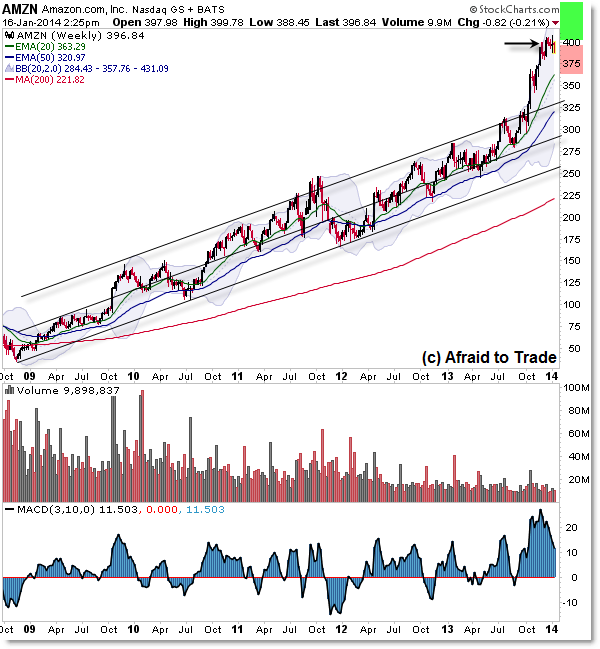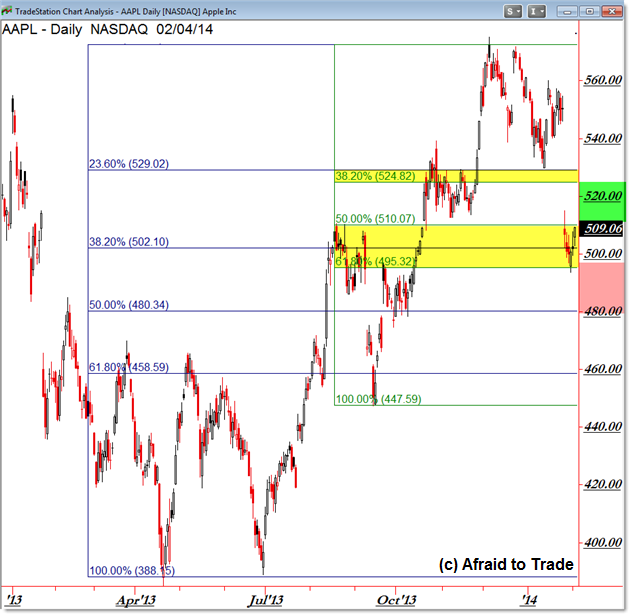Swing Trading Spotting the Six Best Swing Reversals Apple Inc (NASDAQ AAPL)
Post on: 15 Июль, 2015 No Comment

This article is the last of six on the topic of using options to swing trade. The topic in this article is how to spot reversal using a variety of indicators.
The whole concept of swing trading rests on the premise that short-term price movement (especially in reaction to news, rumors or surprises) tends to be exaggerated. It also tends to self-correct within two to five sessions. So a swing trade usually lasts for this duration and is based on making a move counter to the emotions of the market.
Swing traders rely on three primary reversal signals. These are:
1. Reversal day. A fundamental rule about reversal is that you have to have a short-term trend to reverse. An uptrend is defined by swing traders as three or more consecutive sessions, with each session opening higher than the previous open, and also closing higher than the previous close (higher lows followed by higher highs). A downtrend is the opposite, consisting of three or more consecutive sessions with lower opening prices than the prior, and closing lower (lower highs and lower lows).
So once these conditions are in place, a reversal is possible. A “reversal day” is just that, a downward-moving session after an uptrend, or an upward-moving session after a downtrend. This is the most basic of reversal signals, and also the least reliable. You need confirmation from another reversal signal before you can rely on the reversal day.
2. Narrow-range day, or NRD. This is a session with an exceptionally small span between opening and closing price. Candlestick chartists call this a doji, a Japanese word meaning “mistake.” The most extreme NRD is a session opening and closing at the same price, and on a candlestick chart this is a horizontal line rather than a rectangle. This is a very strong reversal indicator, a signal that momentum has shifted from buyers (in the uptrend) to sellers, or from sellers (in a downtrend) to buyers.
3. Volume spike. The third swing trading reversal signal is the volume spike, any session on which volume is considerably higher than previous days. This is a very strong indicator and should not be ignored.
Whenever you find two of these three signals at the same time (like a volume spike on a NRD session, for example), the likelihood of reversal is very strong. Never act on a solitary reversal signal, but rely on indicator and confirmation.
Beyond the standard swing trading reversals are dozens of other possibilities. These include:
4. Traditional Western reversals. Look for double tops or bottoms, head and shoulders, and price gapping runs to spot potential reversal. An actual reversal is most likely when price approaches and tests resistance or support. Even if price does break through, look for price or momentum weakness to foreshadow likely retreat.
5. Momentum oscillators. Among the great reversal signals are changes in momentum. Indicators like RSI or MACD reveal when momentum is declining for the side in control. Thus, when buyer momentum is weakening, an overbought signal is going to pop up, and when seller momentum is weakening, you will find the indicator moving into the oversold range.
6. Candlestick reversals. The candlestick chart is one of the most important of technical tools. Dozens of reversal signals involving one, two or three sessions are likely to lead to better than average timing of both entry and exit. Swing traders benefit greatly by using these.

The three-month chart for Apple Computer (NASDAQ: AAPL ) as of mid-March, 2012 shows examples of all six reversal indicators. First is the gap and breakout, which are traditional Western-style technical indicators. Note how the price jumped above the established resistance level and then continued upward in a new range. Second was a predictive signal in Relative Strength Index (RSI), a momentum oscillator. From here to the end of the charted period, RSI indicated an overbought condition.
The next two are a reversal day (a downward-moving candlestick after a well-established uptrend), and a volume spike. These two occurring together are usually very strong, but in this case, the expected reversal did not occur. Next was an example of a narrow-range day (NRD), which was followed by a very brief downturn in price.
Finally, the next uptrend was strongly predicted buy a bullish two-session candlestick reversal signal, a bullish meeting lines. This consisted on the black candle whose closing price was at the same point as the closing price of the upward-moving next session.
Swing trading relies on your ability to time entry and exit, and this is why you need the best reversal indicators and confirmation. A disconnect is found, however, among swing traders using stock and option traders. Options people tend to rely exclusively on implied volatility tests before deciding to trade positions, and may easily overlook the great value to the six ranges of reversal indicators above.
Options used for swing trading allows great leverage and reduced risk. However, the most powerful swing trading system combines ATM or slightly ITM soon-to-expire options, with the full range of reversal signals. These two in combination — and based on smart confirmation steps — greatly increases the rate of success in a swing trading program.
Whether you use options or other strategies, you can expand your trading with numerous low-risk ideas and make the whole thing quick and easy. Check the many ideas for trading secrets at this link if you want to expand into options and beyond while keeping risks as low as possible. Options are exceptionally flexible products for swing trading, and they allow traders to control risks while leveraging capital, in a lower-risk method than with shares of stock.
2015 Benzinga.com. Benzinga does not provide investment advice. All rights reserved.














